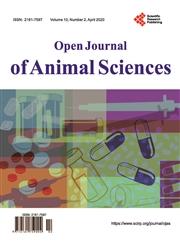Liquid Storage of Ram Semen: Associated Damages and Improvement
引用次数: 8
Abstract
The successful application of assisted reproductive techniques (ARTs) in ovine as in other mammal species relies on many factors among which the quality of the semen used. After collection, semen samples are generally processed for storage (liquid storage or cryoconservation) before being used for insemination or in vitro embryo production. During the liquid storage process, sperm cells are exposed to artificial conditions which lead to oxidative stress—the imbalance between pro-oxidants and antioxidants (AO), following overproduction of reactive oxygen species (ROS)—resulting in ultrastructural, biochemical and functional damages of spermatozoa. Especially, viability, motility, mitochondrial activity, membrane integrity, and acrosome integrity are reduced while morphological abnormalities, DNA fragmentation, and lipid peroxidation (LPO) are increased, affecting the fertilizing ability and subsequent early embryonic development when using standard extenders. Indeed, an optimal semen extender must not only regulate and support an environment of adequate pH and buffering capacity to protect spermatozoa from osmotic and cooling stresses, but, also prevent the generation and/or scavenge excess ROS. To improve ram semen liquid storage, several methods have been developed with the supplementation of extenders with antioxidants or antioxidant like-compounds (enzymes, amino-acids, vitamins, plant extracts), seminal plasma, sugars, fatty acids, and nanoparticles being a relevant approach. Promising results have been registered with the supplementation of extenders with these compounds, confirming they can be used to preserve ram semen quality and fertility. Therefore, the present review provides an updated overview of the damages and associated mechanisms that ram spermatozoa undergo during liquid storage. Moreover, the supplementation of extenders with different compounds as a tool to improve semen storage is also discussed as well as their efficiency to reduce and/or prevent sperm damages during storage.公羊精液液体储存:相关损害及改进
辅助生殖技术在绵羊和其他哺乳动物中的成功应用取决于许多因素,其中所用精液的质量。精液样本采集后,通常在用于受精或体外胚胎生产之前进行储存(液体储存或冷冻保存)处理。在液体储存过程中,精子细胞暴露在人工条件下,导致氧化应激——活性氧(ROS)过量产生后,促氧化剂和抗氧化剂(AO)之间的失衡——导致精子的超微结构、生化和功能损伤。特别是,当使用标准填充剂时,活力、运动性、线粒体活性、膜完整性和顶体完整性降低,而形态异常、DNA断裂和脂质过氧化(LPO)增加,影响受精能力和随后的早期胚胎发育。事实上,最佳的精液扩展器不仅必须调节和支持具有足够pH和缓冲能力的环境,以保护精子免受渗透和冷却应激的影响,而且还必须防止产生和/或清除过量的ROS。为了改善公羊精液的储存,已经开发了几种方法,其中添加抗氧化剂或类似抗氧化剂的化合物(酶、氨基酸、维生素、植物提取物)、精浆、糖、脂肪酸和纳米颗粒是一种相关的方法。通过添加这些化合物的填充剂,已经取得了有希望的结果,证实它们可以用来保持公羊精液的质量和生育能力。因此,本综述提供了公羊精子在液体储存过程中所遭受的损伤和相关机制的最新综述。此外,还讨论了添加不同化合物的填充剂作为改善精液储存的工具,以及它们在储存过程中减少和/或防止精子损伤的效率。
本文章由计算机程序翻译,如有差异,请以英文原文为准。
求助全文
约1分钟内获得全文
求助全文

 求助内容:
求助内容: 应助结果提醒方式:
应助结果提醒方式:


